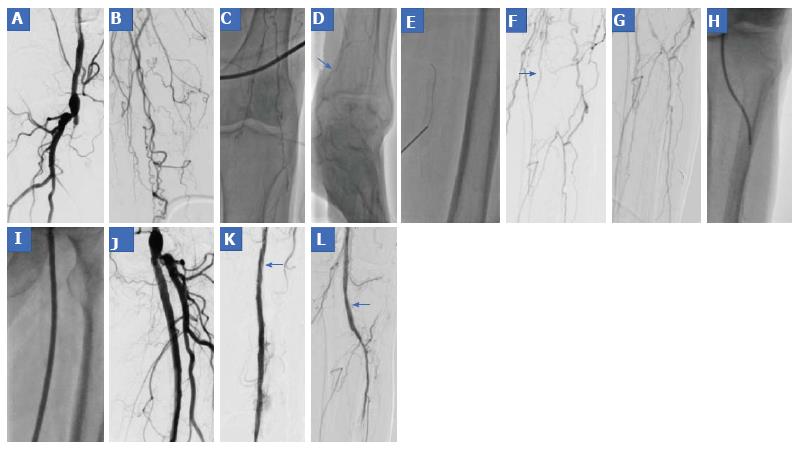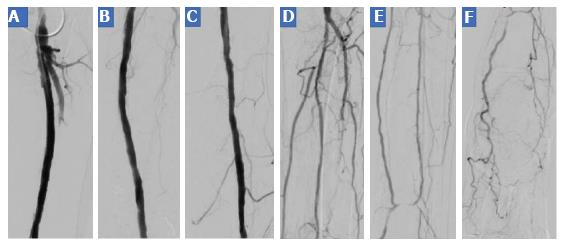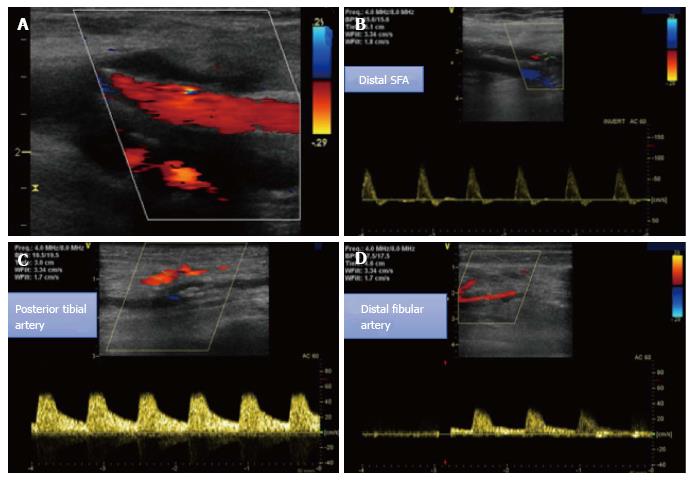Copyright
©The Author(s) 2017.
World J Cardiol. Dec 26, 2017; 9(12): 842-847
Published online Dec 26, 2017. doi: 10.4330/wjc.v9.i12.842
Published online Dec 26, 2017. doi: 10.4330/wjc.v9.i12.842
Figure 1 Duplex sonography and magnetic resonance angiography findings.
A: Biphasic flow in the left common femoral artery; B: Blunted monophasic flow in the posterior tibial artery due to long occlusive disease; C: Absence of flow limiting stenosis in iliac arteries by magnetic resonance angiography; D: Long total occlusion of the SFA (blue arrow) and of the popliteal artery; E: Collateral filling in the proximal part of the posterior tibial artery (blue arrow). SFA: Superficial femoral artery.
Figure 2 Digital subtraction angiography in the first interventional session.
A-D: Long occlusion of the left SFA and of the popliteal artery with scarce filling of the posterior tibial artery (blue arrow in D); E: After failed antegrade crossing direct stent puncture at the level of the mid SFA was performed, achieving retrograde intraluminal passage; F: After snaring the guidewire, a 0.035’’ TrailBlazer support catheter was antegrade advanced to the level of the popliteal artery (blue arrow); G: A 0.014’’ advantage guidewire was used to wire the anterior tibial artery; H-I: Balloon angioplasty; J-L: Final angiographic result. SFA: Superficial femoral artery.
Figure 3 Digital subtraction angiography in the second interventional session.
A, B: DSA images of the SFA; C: DSA image of popliteal artery; D-F: DSA images of crural and foot arteries after the second angiographic procedure. SFA: Superficial femoral artery; DSA: Digital subtraction angiography.
Figure 4 Duplex sonography at follow-up.
A, B: Well perfused SFA with biphasic flow in the distal SFA and in the popliteal artery; C, D: Monophasic flow in the distal posterior tibial and fibular arteries. SFA: Superficial femoral artery.
- Citation: Korosoglou G, Eisele T, Raupp D, Eisenbach C, Giusca S. Successful recanalization of long femoro-crural occlusive disease after failed bypass surgery. World J Cardiol 2017; 9(12): 842-847
- URL: https://www.wjgnet.com/1949-8462/full/v9/i12/842.htm
- DOI: https://dx.doi.org/10.4330/wjc.v9.i12.842












